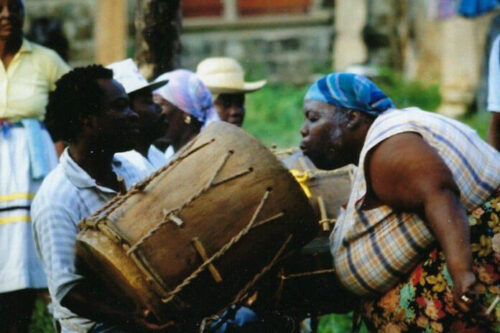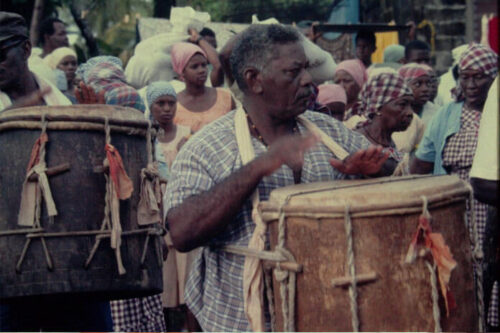This year’s Garifuna Survival Day, April 12th, marks the 224th anniversary of the first arrival of the Garinagu in Roatan, after being exiled by the British from their homeland Caribbean island of St. Vincent. That fateful day marked the culmination of decades of bitter struggle by the Garinagu to protect their lands against marauding British colonists who desired these choice properties to expand their sugar plantations.
The struggle between the native Garinagu and the British started soon after Great Britain gained possession of St. Vincent (as well as Dominica, Tobago, Grenada, and Grenadines) through the 1763 Treaty of Paris. Between 1764 and 1770, while the British surveyed and mapped their newly gained island of St. Vincent, they established that the Garinagu had more land than they needed or could use.

(photo by Kathryn Ross)
As was their practice in other parts of the world, the British tried various strategies – including bribery, intimidation, and force – to get the Garinagu to relocate from the vast expanse of fertile lands that they traditionally occupied. In 1772, when the Garinagu refused to give up their lands, open warfare broke out. British troops had to be brought in from Boston as reinforcement for “calming” the Garinagu. Consequently, the Garinagu lost almost all except 4,000 acres of their lands in the northeastern part of the island.
After that first British-Carib War, and considering the fierce and rebellious nature of the Garinagu that was displayed in their efforts to protect their lands, the British seriously contemplated their total removal from St. Vincent. In a letter dated April 18, 1772, the governor of St. Vincent was given official instructions that, “if necessity demands the removal of the charribbs (Garinagu) you do take up such vessels as can be procured, to serve as transports for the conveyance of them to some unfrequented part of the coast of Africa or to some desert island adjacent thereto…” This instruction would be followed 25 years later almost to date when the Garinagu were banished to the island of Roatan on April 12, 1797.
With the British demands for more Garinagu lands, and also due to fear that the Garinagu would influence the British slaves to revolt, another Carib War broke out between 1795 and ‘96. With their superior military position, along with thousands of British troops sent as reinforcement, the British required the Garinagu to surrender unconditionally. The Garinagu refused to surrender, as this meant the loss of their entire homeland, their culture, and their lives. Consequently, the British mercilessly hunted them down, burnt their houses, canoes, and crops, and confiscated their stores of food.

By October 1796, a total of 4,195 Garifuna men, women and children, along with 44 enslaved Africans that were owned, and 102 “Yellow Caribs” were captured and transported to the barren rock island of Baliceaux while decisions were being made about whether to send them to Africa, the Bahamas, or the peninsula of Samana on the island of Hispaniola. By March 1797, about 2,400 Garifuna persons died in an epidemic, probably typhus or yellow fever, which was aggravated by malnutrition and the horrendous living conditions of Baliceaux.
On March 3, 1797, the remaining 2,248 Garifuna men, women, and children (some of whom were still sick) were loaded onto a convoy of eight or nine ships under the command of Captain John Barret in the flagship Experiment. The lighter skin Yellow Caribs were returned to St. Vincent. On March 11th the convoy set sail from the only homeland that the Garinagu had ever known, to be banished forever. It was predicted that this exile would result in their total extinction as a people.
On April 11, 1797, after a perilous journey of about 3,000 miles, including a stop in Jamaica to service and repair the ships, the convoy landed in Roatan and offloaded 2,026 Garifuna men, women, and children who survived. Considering that many were ill even at the start of the journey, 222 Garifuna perished along the way and their bodies most likely were dumped overboard.
In 1802, within five years of their expulsion and new settlement in Roatan, 150 Garifuna laborers were imported to the settlement of Belize and then immediately deployed further south to serve as woodcutters in Belize’s expanding mahogany industry. In order to restrain the potential for fomenting rebellion in the settlement, Garinagu were kept away from enslaved Africans. They were placed in the territory south of the then Sibun River boundary that would later become a part of the territory of Belize. By the end of the 1800s, Garifuna teachers would serve as outstanding teachers within the Catholic school system to pioneer the opening of schools in remote communities throughout Belize.
Despite their near extinction and centuries of oppression, discrimination, and ridicule for their unique culture, the Garinagu, as the first free black group in the Americas during those centuries of slavery, amazingly maintained their language, spirituality, music, dance, and other aspects of their traditional culture to this day. Since 2001, the uniqueness of the Garifuna language, culture and music has been internationally recognized and proclaimed by UNESCO to be a “Masterpiece of the Oral and Intangible Heritage of Humanity”. In the countries of Honduras, Guatemala, Nicaragua, and Belize, where their many Garifuna communities continue to survive, Garinagu distinguished themselves through several fields of national development.
As the pictures show, Garifuna spirituality, through which they honor their deep connections to the ancestors and ancestral traditions, remain central to their survival to this day. In many ways, the deep struggle and blood spilled by the ancestors to stubbornly guard, defend and maintain their culture continues to inspire Garinagu to remain connected and reconnected to the values that they hold dear.

participating in spiritual ceremony in honor of the ancestors, 1996. (photo by Kathryn Ross)
As Garinagu light their candles in honor of the ancestors, there is much to be very grateful for. Through all those attempts to break us, we have survived. Yes, there are still difficult struggles against persistent discrimination in our various communities and efforts across boundaries to dishonor and alienate Garinagu, but we must continue to honor the journey that has brought us this far. As we continue our struggles into the future, the timeless values of our ancestors hold true in ways quite similar to the spirit of Ubuntu: – I am, because we are. Our collective well-being is intricately bound to each other’s well-being. I am for you and you for me. Au buhn, amürü nu. Itarala!
Reference: Nancie L. Gonzalez, 1988. Sojourners of the Caribbean: Ethnogenesis and Ethnohistory of the Garifuna

